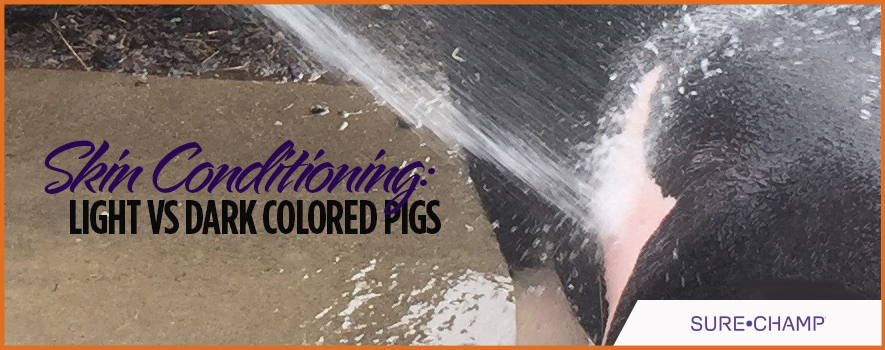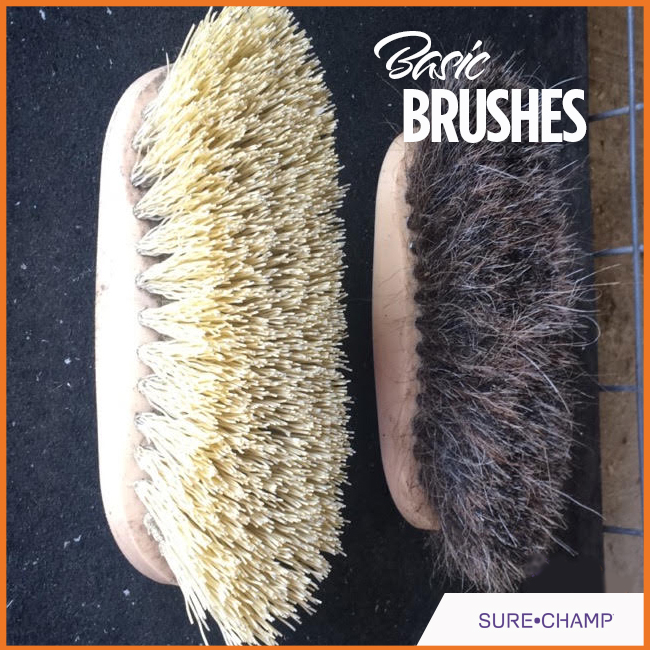
Skin and hair is only one part of being sure your animal looks maxed out and one hundred percent on show day. At the same time, it is one of the most important factors when it comes time to “look like a winner.”
Your pig having a fresh look depends on many physical characteristics from a feeding standpoint, but the presentation of their clean, fresh skin, and trained and groomed hair laying the right direction falls a very close second in line.
A great lesson I’ve learned over the years is there are the basics in day-to-day care that fit all pigs, but dark colored pigs and light colored pigs must be treated differently as far as their skin to make them look their absolute best. Below are some of the basic procedures I’ve found that work.
 Brushing Routine
Brushing Routine
Pigs need to be brushed every day or at least 4-5 times a week. This enhances the training of their hair and helps clean the pores of their skin, which will further promote a healthy look.
When brushing remember to always and only brush in the direction that allows the hair to lay smoothly and not curling anywhere. Also, brush the pig’s entire body, including the legs. Many times I see kids’ pigs where the top of their pig look nearly perfect, but halfway down their side, and their legs hair is going every direction. Additionally, in today’s times, when judges are placing much emphasis on heaviness of structure, brushing the pigs’ legs promotes hair growth and trains the hair to lay in the right direction, which makes them look bigger boned.
Over the years I’ve found that there are a couple of types of brushes that are a must to maximize this procedure as well. The two types of brushes I recommend to keep around and use is a soft “horse hair” brush and a tougher “rice root” brush. The way I use the two differ a bit depending on light colored vs. dark colored pigs.
On light colored pigs, I recommend using a rice root brush at least 3-5 times per week. There are a couple advantages of this tougher bristled brush. One is that it removes more of the dirt particles out of their skin, which on white pigs allows them to be a brighter white. Second, it toughens their skin, particularly where we will use a show whip along their side and the side of their face, which will result in less “marking up” by this tool when showing. And finally, this type of brush allows the release more of the natural oils in a pigs skin to promote a healthy hide and hair coat.
On dark colored pigs, I recommend using a rice root brush at least 1-2 times weekly. This is for the same reason I spoke of on light colored pigs, however I don’t feel it to be necessary to use as often because we have less worry of toughening the skin for markings from a show stick like we do on those light colored ones because of their darker pigment.
The other brush I recommend to use on all pigs regardless of color is a soft “horse hair” brush. This brush is much softer to a pig’s skin and works better for getting their hair to lay correctly and is a better suited brush when applying conditioners and oils with. I would keep at least two of each brush on hand, one brush for oil products and one for non-oil products. This is also good practice because most show have rules against using oil based product in the show ring and you’ll need non-oil brushes to get pigs ready to go into the show ring.
 As far as which type of conditioners to use, there are many great products on the market and the key is finding one that works best for you. Again, this is where I divide how I recommend treating light colored vs. dark colored pigs. On light colored pigs, I never recommend using an oil-based product. To me, this only adds to dirt and grime build up which dulls the bright white color of their skin. On light colored pigs use a non-oil conditioner, and apply 3-4 times a week. As stated earlier, using a tougher brush, such as a rice root brush is also going to work natural oils out of the pigs’ pores.
As far as which type of conditioners to use, there are many great products on the market and the key is finding one that works best for you. Again, this is where I divide how I recommend treating light colored vs. dark colored pigs. On light colored pigs, I never recommend using an oil-based product. To me, this only adds to dirt and grime build up which dulls the bright white color of their skin. On light colored pigs use a non-oil conditioner, and apply 3-4 times a week. As stated earlier, using a tougher brush, such as a rice root brush is also going to work natural oils out of the pigs’ pores.
On dark colored pigs, I prefer oil-based products. Naturally oil based products are more effective in moisturizing a pigs’ skin. Another, ingredient you see in many oil products is citronella. During the summer, this is helpful because citronella is a natural insect repellent, so products with citronella included in them, will also help battle flies, mosquitoes and other bugs that may bother your pig’s skin. Be cautious during the heat using oil-based products as they will clog the pores of pigs and only make them hotter. During the summer time, I try to only apply oil late in the evening when it is cooler.
Remember we still need to brush daily even though we’re only applying oils/conditioners 3-4 times per week.
I’ve mentioned a few times about the importance of making light colored pigs a bright white. It is equally important for dark colored pigs to have a dark pigment. Allowing your black or red pigs to have a darker pigment is much more appealing versus an “ashy” light color. To fix this, we need to get dark pigmented pigs in the sun to “tan”. Just as people’s skin reacts differently to the sunlight, pigs are the same way. Some get dark quickly and others take some time. The number one rule I would give you is to not suntan for any longer than 20-30 minutes per session and no more than 10 minutes per session for the first 4-5 sessions to prevent sunburn. If you have a belted pig, put sunscreen on the white parts of their body. I don’t recommend applying oil when suntanning. Although it does attract more sunlight, it also leads to the animal becoming warmer, quickly and increases the odds of getting sunburnt. Finally, under no circumstances leave your pig outside in a pen to suntan. Always stay around in case they become uncomfortable, or get hot and need to be taken back inside.
Washing is another process that all pigs need. I only recommend washing once per week. During warm months, you may need to rinse more often than this, which is fine, but I don’t like to wash with soap more than once weekly. Another thing to keep in mind is always use a conditioner after you’ve washed your pig. Naturally soap is going to dry your pig’s skin out some, so it’s important to replenish the condition of their skin after washing with an oil/conditioner. Remember when washing to wash the entire pig from nose to tail, and all the way down their legs.
These are very basic tips and procedures about conditioning for light and dark colored pigs and the minor differences between the two, but the little things all add up and become big things in the show ring.

